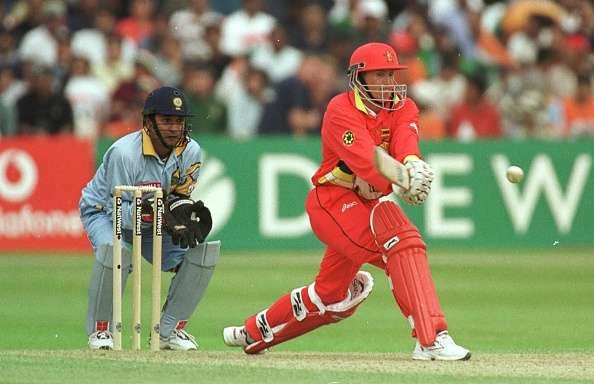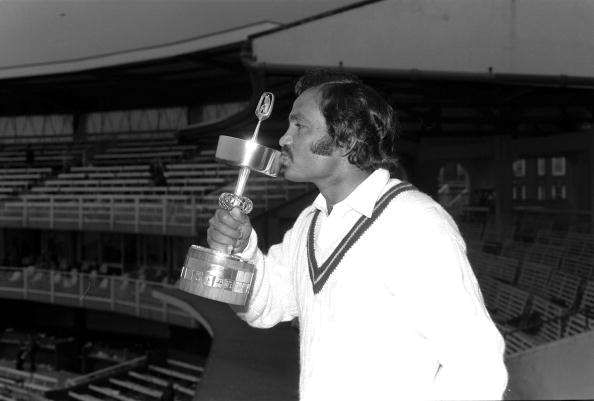
SK Demystifies: Andy Flower's remarkable reverse sweep
In sharp contrast to their current travails, the Zimbabwean cricket team of the 90s and early 2000s was filled with plenty of household names. The most popular among those was Andy Flower who went on to carve a niche for himself in the annals of the game.
Even though he scored more than 10,000 runs in Tests and ODIs combined, the left-hander’s enduring legacy remains his mastery over the reverse sweep. Predominantly used against spin, the exotic shot confounded accomplished bowlers as well as sharp skippers.
Extra Cover: SK Demystifies – Douglas Marillier's trend-setting scoop shot
Despite the shot containing intrinsic risks, Flower’s exemplary execution turned the reverse sweep into a viable option. Targeting the area between deep point and third man on a relentless basis, the southpaw used the stroke as a means to accumulate vital runs.
The advantages of relying on the reverse sweep are manifold. Apart from putting the bowler off his lengths, the shot also makes it rather difficult for captains to set feasible fields. While the stroke applies significant pressure on spinners in limited-overs cricket, it plays a key role in disrupting the bowler’s concentration at Test level too.
Mushtaq Mohammad’s gift
The origin of the reverse sweep can be traced to Mushtaq Mohammad. Aside from being an enterprising right-hander, the Pakistani icon was also a quirky leg-spinner capable of turning many a match on its head. Even though he instilled plenty of self-belief in a struggling team and converted a modest crew into capable cricketers, the all rounder’s greatest contribution to the game stems from his ingenuity.
Mushtaq would later reveal to The Indian Express that he devised the reverse sweep during a club game in England. With Sundays usually kept aside as off-days during the County Season, he dabbled his hand in club cricket in order to supplement his income. During one such fixture for Rothmans Cavaliers in 1964, he unfurled what would be the first documented instance of the reverse sweep.
With veteran off-spinner Fred Titmus’s guile as well as an intelligently laid field setting stifling his productivity, Mushtaq came up with an outlandish shot to exploit the gap at third man. The pre-meditated stroke went for a boundary and caught the bowler by complete surprise.
Notwithstanding Titmus‘s fervent appeal, the umpire backed the batsman’s invention. Therein, the legend of the reverse sweep was born and Mushtaq became a trendsetter of sorts.
Flower perfects the art
Arguably, the finest piece of batting by a Zimbabwean came in 2000 against India at the Vidarbha Cricket Association (VCA) Stadium in Nagpur. Having been humbled by 7 wickets in the opening match of the series, the visitors came into the second Test low on confidence.
On a typically docile subcontinental surface, India won a handy toss and had no hesitation in batting first. Riding on centuries from Shiv Sunder Das and Rahul Dravid as well as a double ton from Sachin Tendulkar, they amassed more than 600 runs in the first innings.
Despite their valiant fight, Zimbabwe could only manage 382 in reply. Forced to follow on, they were staring down the barrel at 166/4 when Andy Flower took charge. On a surface which had begun to deteriorate rapidly, he put on an exhibition of sublime batting against seasoned spinners.
Extra Cover: The enigma of Andy Flower - The forgotten Test great
One of the fascinating facets of his knock was the sheer nonchalance with which the left-hander played the reverse sweep. Acknowledging that the innovative shot was a percentage option to counter the rough around the leg-stump, he kept hitting across the line and had the Indians on tenterhooks.
Flower’s reverse sweep-laden knock propelled Zimbabwe to a mammoth second-innings total of 503 for the loss of just six wickets. The southpaw’s unbeaten 444-ball 232 helped his team salvage a draw and prevent an ignominious whitewash.
Executing the flawless reverse sweep
(Video Courtesy: England & Wales Cricket Board)
According to England star Eoin Morgan, the key to executing the flawless reverse sweep involves the following steps:
The batsman has to set a strong base with the head coming forward and the front knee lowered so that the former is just over the latter. This ensures that a solid foundation is established and he/she is able to get in such a position so as to contact the ball at the precise moment.
The vital part lies in moving both hands through and across the front knee. Such movement of the hands prevents the bat from being caught anywhere out of position. This also allows the batsman to manoeuvre the ball in the preferred location between point and backward point.
Just before making contact with the ball, the batsman has to change the grip at the last instant and use the flow of the bat to find the gaps. In the case of going the aerial route, the batsman meets the ball on the up and lifts it by utilising the newly generated momentum.
As with any innovative shot, the key in pulling off the reverse sweep lies in the execution. If done properly, the stroke can go a long way in breaking the bowler’s rhythm and providing a sense of conviction to the batsman. After all, the greater the risk, the bigger the reward.


